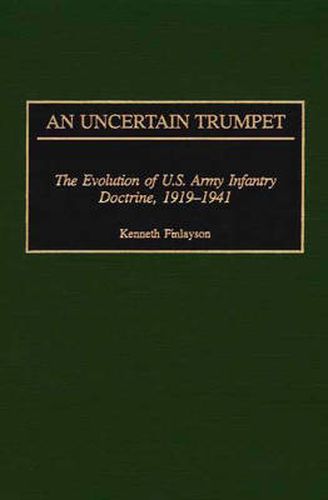Readings Newsletter
Become a Readings Member to make your shopping experience even easier.
Sign in or sign up for free!
You’re not far away from qualifying for FREE standard shipping within Australia
You’ve qualified for FREE standard shipping within Australia
The cart is loading…






Faced with severe budgetary constraints, a radically reduced force structure, and a crippling intellectual dogmatism, the American Infantry struggled throughout the interwar years to modernize its doctrine. Finlayson examines these difficulties, beginning with an overview of the experiences of the primary combatants of the First World War, comparing their battlefield doctrines with that of the American Expeditionary Force. The brief American appearance on the battlefield did much to shape the convictions of those men assigned the task of developing doctrine after the war.
The findings of the post-World War I Superior Board provide valuable insight into how institutional conservatism and the dogmatic approach to new ideas that existed among senior Army leaders stymied possible doctrinal advances. The Army would suffer greatly in the post-war demobilization and the subsequent ravages of the Great Depression. With little money and few soldiers spread around far-flung posts, little advancement in terms of doctrinal development was possible. As the likelihood of war became more imminent in the 1930s, a concerted effort to modernize was made; however, the magnitude of the task made success virtually impossible-a situation that was evident in the Infantry’s poor performance in the early battles of the war. The U.S. entry into World war II would, unfortunately, find the infantry branch only partially prepared for the battle field of 1942.
$9.00 standard shipping within Australia
FREE standard shipping within Australia for orders over $100.00
Express & International shipping calculated at checkout
Faced with severe budgetary constraints, a radically reduced force structure, and a crippling intellectual dogmatism, the American Infantry struggled throughout the interwar years to modernize its doctrine. Finlayson examines these difficulties, beginning with an overview of the experiences of the primary combatants of the First World War, comparing their battlefield doctrines with that of the American Expeditionary Force. The brief American appearance on the battlefield did much to shape the convictions of those men assigned the task of developing doctrine after the war.
The findings of the post-World War I Superior Board provide valuable insight into how institutional conservatism and the dogmatic approach to new ideas that existed among senior Army leaders stymied possible doctrinal advances. The Army would suffer greatly in the post-war demobilization and the subsequent ravages of the Great Depression. With little money and few soldiers spread around far-flung posts, little advancement in terms of doctrinal development was possible. As the likelihood of war became more imminent in the 1930s, a concerted effort to modernize was made; however, the magnitude of the task made success virtually impossible-a situation that was evident in the Infantry’s poor performance in the early battles of the war. The U.S. entry into World war II would, unfortunately, find the infantry branch only partially prepared for the battle field of 1942.